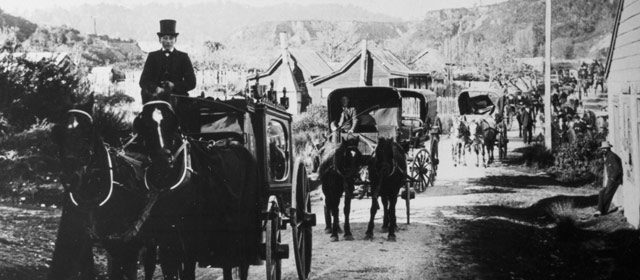Story summary
Dying
In the late 1800s and early 1900s most people died at home, cared for by family. In the 21st century most people die in hospital or in a hospice (a place where the dying are cared for).
Different cultures and religions have particular traditions of what is said and done while someone is dying and after they have died. For example, a dying Catholic may want to receive holy communion.
After death
After death, bodies are usually laid out – cleaned, dressed and put in a coffin. In the past this was usually done by a female relative, but it is now almost always done by a funeral director. In the 21st century bodies are usually embalmed – preserved with chemicals. Family and friends will often go to a funeral home to view the body.
Tangihanga
Tangihanga, Māori mourning rituals, last several days. Family and friends stay with the body through the whole process, which usually takes place on a marae. Mourners may talk to the dead person, pray, sing or just sit with them.
Funerals
Funerals are a way to farewell the person who has died. They are often held in churches, but may also take place in the chapels of funeral homes, marae, community halls or gardens.
Most funerals are attended mainly by family and friends of the person who died. Others, often for public figures, are larger. State funerals, such as that for mountaineer Sir Edmund Hillary, are televised and attended by large numbers of people.
Different cultures and religions have their own funeral traditions and ceremonies.
Burials and cemeteries
Traditionally Māori would carefully wrap the tūpāpaku (dead body) in mats and cloaks and farewell them on the marae. Tūpāpaku would be buried in a shallow grave or placed in caves or the hollows of trees. Bodies would later be exhumed and the bones washed and scraped. Mourning rituals were held on the marae and the remains buried in secret places.
European settlers began the first cemeteries in the late 1830s. From the 1840s local councils established cemeteries, which were often divided into separate sections for different faiths, such as Anglicans, Dissenters, Catholics and Jews.
Different cultures have their own traditions about burial. Some people prefer natural or eco-burials, where the body is not embalmed and is buried so it can decompose more quickly.
Cremation
Cremation is burning of the body, usually in a furnace at a crematorium. Ashes are given to family members, who bury them, scatter them or keep them in a casket.
The first cremation in New Zealand took place in 1909. The method was more frequently used from the 1960s, and in the early 2010s around 70% of bodies were cremated. Some religions do not allow cremation.
Sometimes people have their pets cremated after they have died.
Euthanasia
Voluntary euthanasia is when a person suffering from an incurable disease asks someone to help them die. Some people are in favour of euthanasia because they believe it gives people the right to die with dignity and without pain. Those against euthanasia believe it devalues human life. In the 21st century a number of high-profile court cases highlighted issues relating to assisted dying. There were several attempts to make assisted dying legal in certain circumstances. This came about in 2021.





